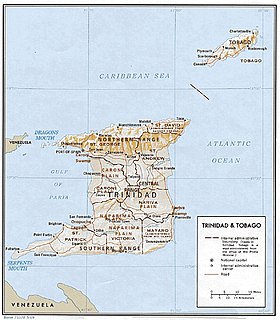
The oilbird, locally known as the guácharo, is a bird species found in the northern areas of South America including the island of Trinidad. It is the only species in the genus Steatornis and the family Steatornithidae. Nesting in colonies in caves, oilbirds are nocturnal feeders on the fruits of the oil palm and tropical laurels. They are the only nocturnal flying fruit-eating birds in the world. They forage at night, with specially adapted eyesight. However they navigate by echolocation in the same way as bats, one of the few birds to do so. They produce a high-pitched clicking sound of around 2 kHz that is audible to humans.
Parang is a popular folk music originating from Venezuela and Trinidad and Tobago, it was brought to Trinidad and Tobago by Venezuelan and Colombian migrants who were primarily of Amerindian, Spanish, Mestizo, Pardo, Cocoa panyol, and African heritage, something which is strongly reflected in the music itself. The word is derived from two Spanish words: parranda, meaning "a spree or fête", and parar meaning "to stop".
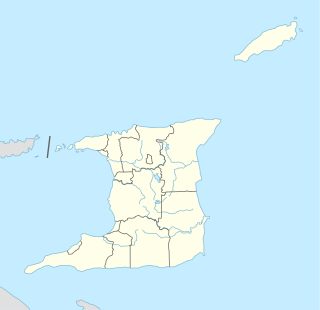
The Asa Wright Nature Centre and Lodge is a nature resort and scientific research station in the Arima Valley of the Northern Range in Trinidad and Tobago. The centre is one of the top birdwatching spots in the Caribbean; a total of 159 species of birds have been recorded there. The centre is owned by a non-profit trust.

El Cerro del Aripo, at 940 metres (3,084 ft), is the highest point in the Republic of Trinidad and Tobago. It is part of the Aripo Massif and is located in the Northern Range on the island of Trinidad, northeast of the town of Arima.

The Panyols are an ethnic group in Trinidad and Tobago of mixed Spanish, Amerindian, Afro-Latin American, and Afro-Trinidadian and Tobagonian descent. They comprise the Cocoa Estate Plantations owners community along with peasant workers from Venezuela and Colombia, also referred to as Cocoa panyols. They were born of the shared Island nation, on both sides of the Gulf of Paria, Peninsulas that settling within the Northern Range Rain Forest Mountains Valleys of Trinidad and Tobago Caura River, down the mountains into the Tacarigua River into the Caroni River, and the Orinoco, and Caura River Venezuela. They played an important role in the development of the cocoa industry in Trinidad and Tobago, running the Cocoa Estate and not to be confused with the freed community of former slaves.
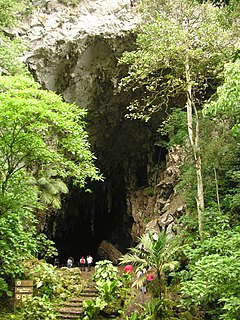
The Guácharo Cave National Park is located 12 km from the town of Caripe, Monagas, Venezuela. It has as its centerpiece a large limestone cave.

Tunapuna–Piarco is one of the 9 regions of Trinidad and Tobago. It is the most populous region in the country by total population and the fifth-largest by total land area. Geographically located in Northern Trinidad, Tunapuna–Piarco shares its borders with the regions of San Juan–Laventille to the west, Couva–Tabaquite–Talparo to the south, the Borough of Chaguanas to the south-west, Sangre Grande to the east and the Caribbean Sea to the north. The region also completely surrounds the Royal Chartered Borough of Arima, which is located in the south-eastern corner of the region.

Cutervo National Park , established in 1961, is the oldest protected area in Peru. It is located in the northern Peruvian Andes, in the region of Cajamarca. The park was extended to 8,214 hectares (31.71 sq mi) and protects areas of Andean montane forests and paramo for headwater conservation. Moreover, those areas are the habitat of animal species like the spectacled bear, the mountain tapir, and the oilbird; and plant species like the Andean wax palms.

The northern ghost bat is a bat species from South America, Trinidad, and Central America. It is a relatively rare, completely white, insectivorous bat, with an unusual sac at the base of its tail.
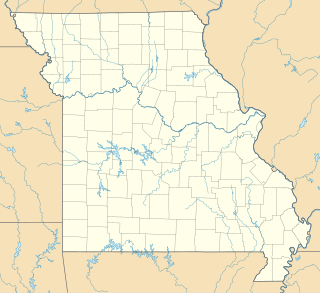
The Big Eddy Site (23CE426) is an archaeological site located in Cedar County, Missouri, which was first excavated in 1997 and is now threatened due to erosion by the Sac River.
Lopinot is a village in Trinidad and Tobago.
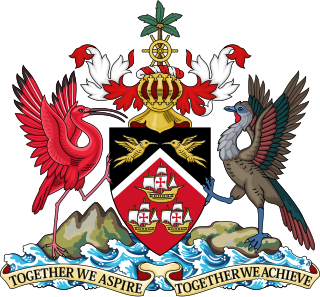
General elections were held in Trinidad and Tobago on 5 November 2007. Nomination day was 15 October.

The Sinaloan mastiff bat is a species of bat in the family Molossidae, native to Mexico, Central America and northern South America.
Aripo Cave is a cave in the Northern Range, in Trinidad and Tobago. This is the longest accessible cave in Trinidad and Tobago, with 862 m length and 160 m depth. It is one of several caves created by recrystallised limestone. The cave is a notable bat roost, and that bats contribute considerable amounts of guano, which in turn support vast numbers of cave-dwelling invertebrates.
Dunston Cave is an igneous cave on the Northern Range of Trinidad and Tobago. The cave is located on the grounds of the Asa Wright Nature Centre. Originally named Guacharo Cave, it was renamed Dunston Cave in 1972 in honour of engineer John Dunston. The caves are home to an Oilbird colony. These are the only nocturnal fruit eating birds in the world. They forage at night, navigating by echolocation in the same way as the bats.
Cumaca Cave is a large cave system located in northern of Trinidad, in the southeastern area of the Northern Range. This cave is sometimes also called Oropouche. The caves are home to bats and Oilbirds. These are the only nocturnal fruit eating birds in the world. They forage at night, navigating by echolocation in the same way as bats, but with a high-pitched clicking sound audible to humans.
La Vache is a cave in located in the Northern Range, on the north coast of Trinidad. The Caves are home to the Oilbirds, These are the only nocturnal fruit eating birds in the world. They forage at night, navigating by echolocation in the same way as bats.
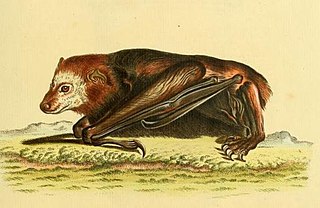
The Trinidad dog-like bat is a species of bat from the family Emballonuridae. It is native to Aruba, French Guinea, Grenada, Trinidad and Tobago, and Venezuela. The bat is considered to be rare everywhere in its geographic range, although this may be untrue, as the Trinidad dog-like bat was previously confused with the lesser dog-like bat. It is an aerial insectivore that roosts in hollow trees, hollow rotten logs on the ground, under overhanging banks, and caves in the Llanos of Venezuela.
Hayne Lincoln Douglas was a Member of Parliament in the House of Representatives in the Republic of Trinidad and Tobago. He entered Parliament in 2010 as the elected Member for Lopinot/Bon Air West, losing his seat in the 2015 elections.

